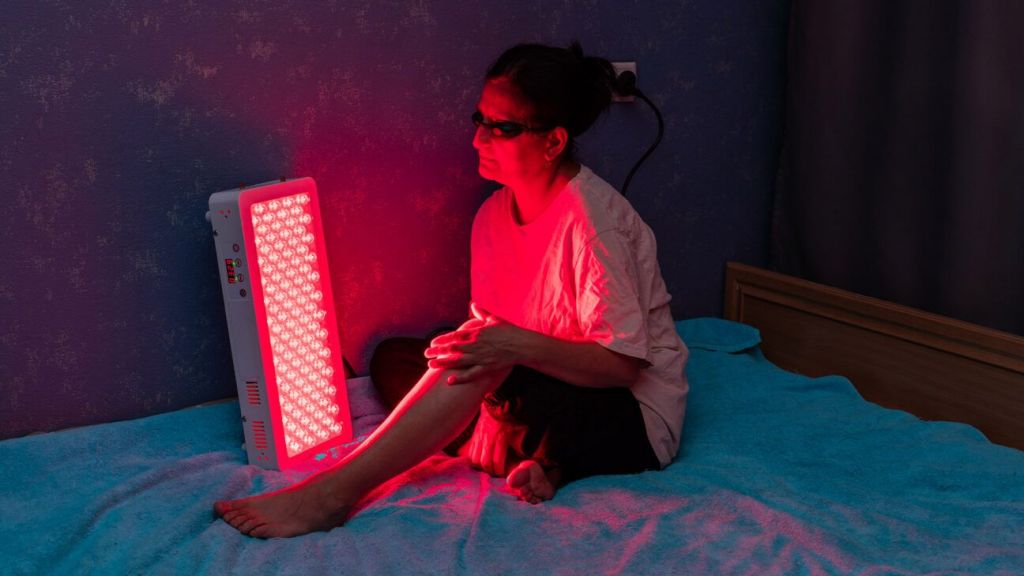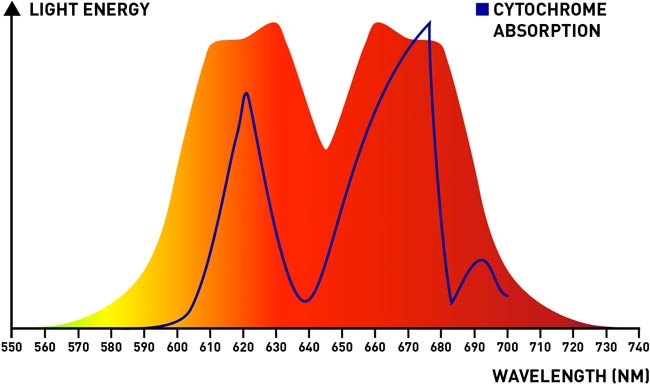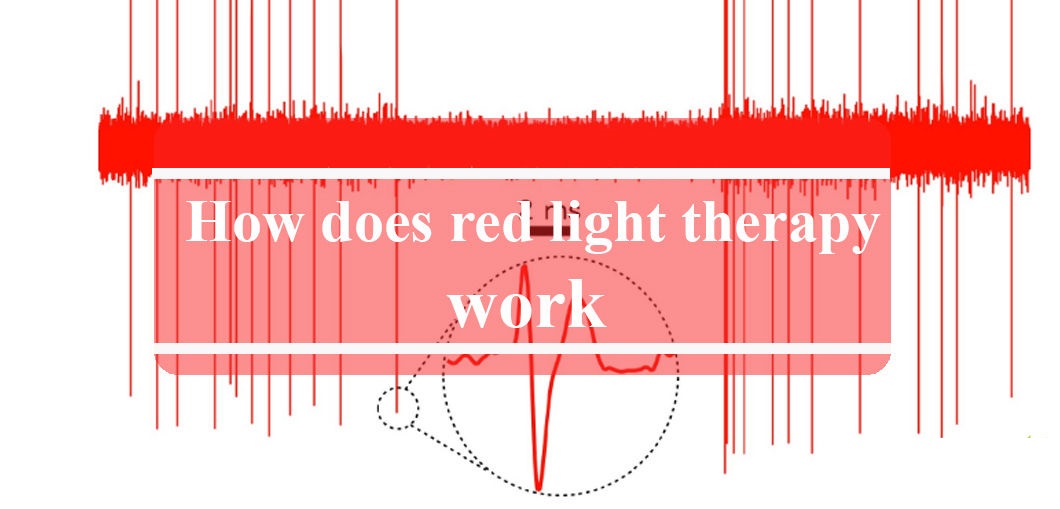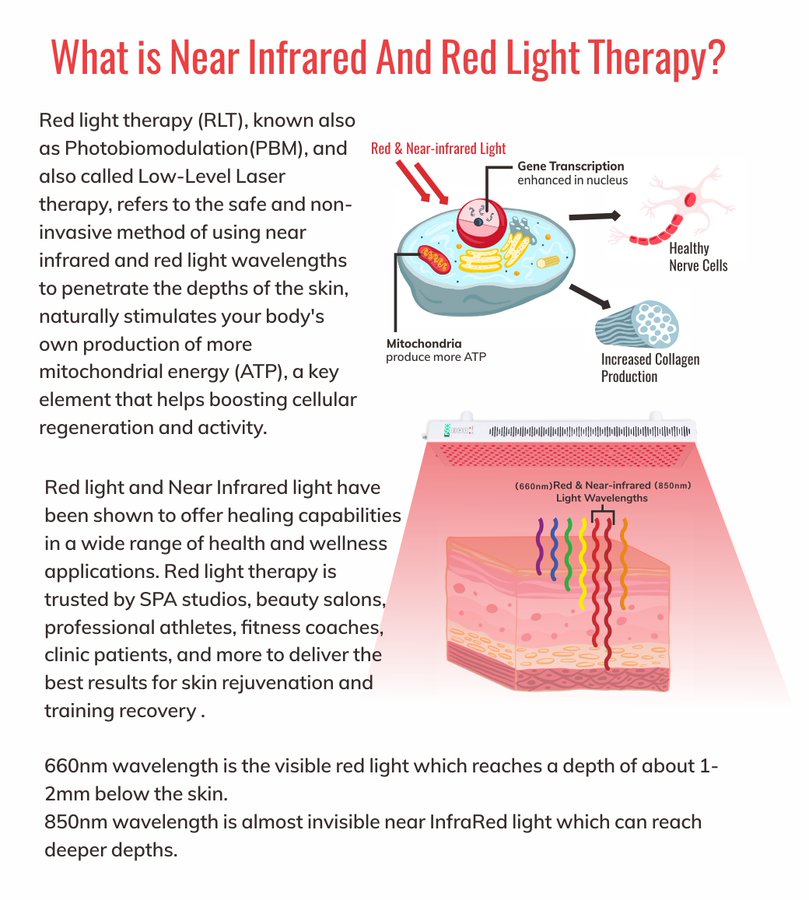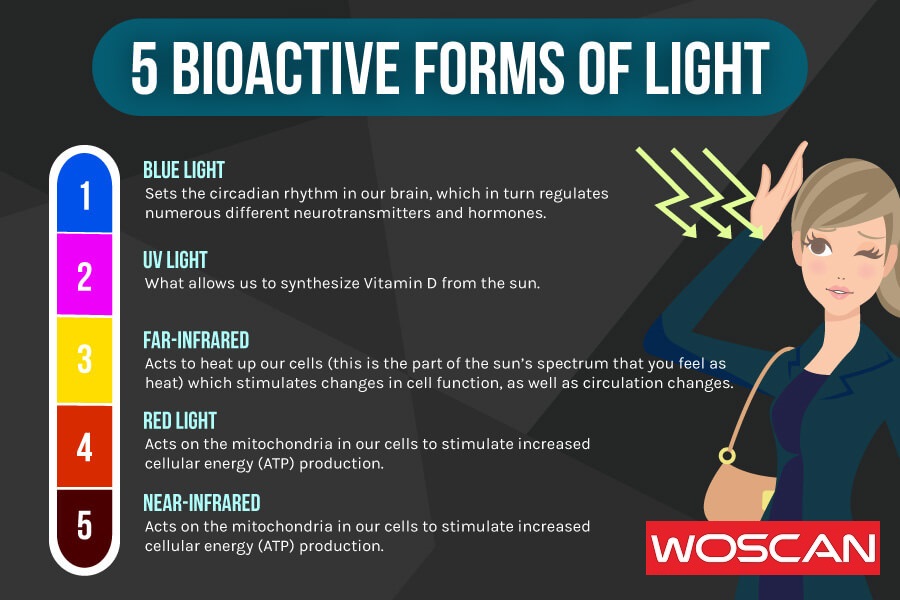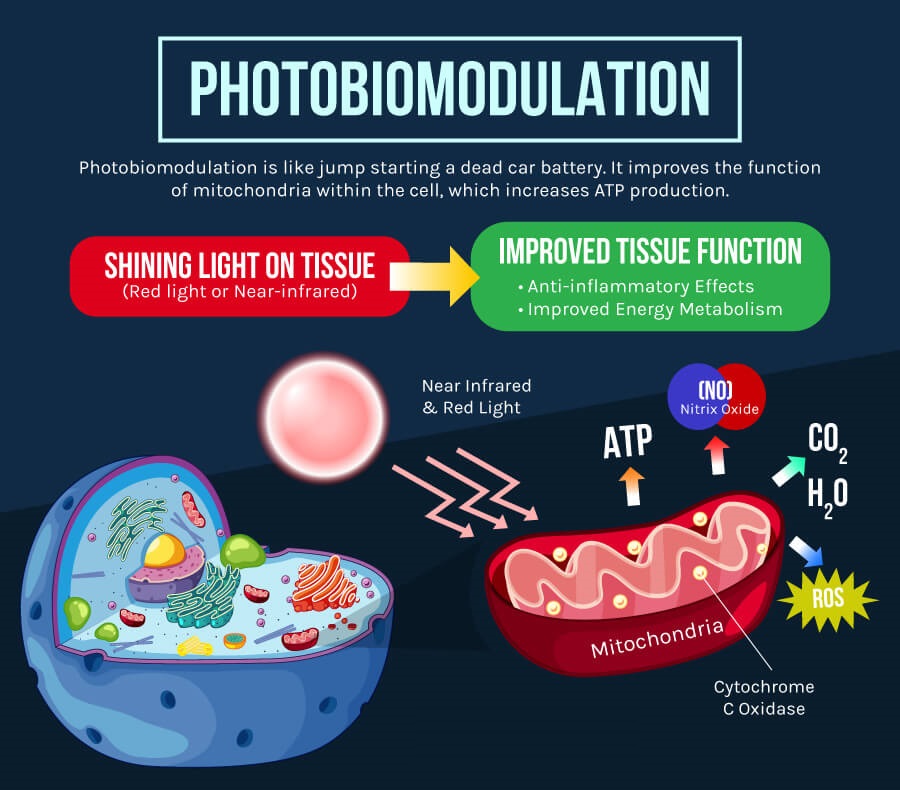
Multiple Sclerosis (MS) is a neurodegenerative autoimmune disorder characterized by the body’s immune system attacking the protective myelin sheath that covers nerve fibers. This can result in communication problems between the brain and the rest of the body, leading to a myriad of symptoms ranging from fatigue and pain to severe mobility challenges.
As the search for alternative therapies intensifies, Red Light Therapy (RLT) is emerging as a potential beacon of hope for many MS patients. This therapy, grounded in the principles of Photobiomodulation, delves deep into the cellular level, harnessing specific wavelengths of light to interact with cellular structures. The result? A cascade of biological responses, from boosting ATP production in the mitochondria to modulating Reactive Oxygen Species (ROS), which can potentially benefit those grappling with MS.
In this article, we will delve deeper into the intricate science behind RLT, unpacking its physiological mechanisms of action, and exploring its potential benefits for those living with Multiple Sclerosis.
What is Red Light Therapy?
Red Light Therapy (RLT) isn’t a novel concept, despite its recent surge in popularity. Historically rooted in ancient civilizations, they recognized the therapeutic potential of sunlight. However, it’s only in recent decades that we’ve harnessed the specific components of light, particularly red and near-infrared wavelengths, for targeted therapeutic purposes.
At its core, RLT operates in a distinct range of wavelengths. This specific spectrum is crucial for its unique physiological effects on the body. To distinguish it from other light-based modalities, RLT does not rely on heat or UV rays to produce its effects. Instead, its efficacy is rooted in the realm of Photobiomodulation.
Photobiomodulation refers to the mechanism where light interacts with cellular structures, leading to various biological responses. One pivotal interaction occurs within the mitochondria, the powerhouse of our cells. Here, light photons are absorbed by an enzyme called cytochrome c oxidase. This absorption stimulates the enzyme, promoting the production of ATP (adenosine triphosphate), the primary energy currency of cells. This cascade of events not only boosts cellular energy but also modulates oxidative stress by balancing the levels of Reactive Oxygen Species (ROS). Furthermore, RLT can promote the release of nitric oxide (NO), a vasodilator that improves circulation and can be instrumental in reducing inflammation.
In essence, Red Light Therapy is not just a simple exposure to a light source. It’s a carefully calibrated interaction of specific wavelengths with our body’s cellular machinery, eliciting responses that can potentially be harnessed for therapeutic benefits.
How Does Red Light Therapy Work?
To grasp the underlying mechanics of Red Light Therapy (RLT), one must delve deep into the cellular and molecular realms of the body. The transformative effects of RLT are not merely superficial interactions with the skin, but profound engagements with our body’s intrinsic processes.
- Cytochrome c oxidase stimulation: At the heart of our cells, within the mitochondria, lies an enzyme named cytochrome c oxidase. This enzyme is particularly sensitive to light, especially the wavelengths employed in RLT. When exposed to these specific wavelengths, cytochrome c oxidase absorbs the light photons, leading to a series of molecular events. As described in a study titled “Cellular Signalling and Photobiomodulation in Chronic Wound Repair“, “PBM stimulates the mitochondria, resulting in an increase in adenosine triphosphate (ATP) production and the downstream release of growth factors.” [1] This increase in ATP provides cells with a higher energy currency, allowing for enhanced cellular functions and repair processes.
- Enhanced ATP (adenosine triphosphate) production: ATP serves as the primary energy molecule in the body. As the study highlighted, RLT directly impacts mitochondrial ATP synthesis, effectively boosting cellular energy. This uptick in energy can rejuvenate cells, aiding in tissue repair, reducing fatigue, and optimizing various physiological processes.
- Modulation of Reactive Oxygen Species (ROS): Cells naturally produce ROS during metabolic processes. While some ROS are beneficial, an imbalance (often skewing towards an excess) can cause oxidative stress, leading to cellular damage. RLT helps modulate ROS levels, ensuring a balance that both supports cellular functions and guards against potential oxidative damage.
- Augmentation of nitric oxide (NO) levels: Nitric oxide plays a dual role in our body. It acts as a neurotransmitter and also as a vasodilator, promoting better blood flow. In the context of Multiple Sclerosis, nitric oxide’s modulation is of particular significance. A study titled “Photobiomodulation at 830 nm Reduced Nitrite Production by Peripheral Blood Mononuclear Cells Isolated from Multiple Sclerosis Subjects” noted, “PBM at 830 nm can potentially be used to reduce nitrosative stress at any point of disease in PwMS.” [2] This suggests that RLT can be pivotal in reducing inflammation and other symptoms associated with MS by modulating nitric oxide levels.
Red Light Therapy is a symphony of cellular interactions. By engaging key molecules and cellular structures, it offers a promising avenue for enhancing cellular function, combating oxidative stress, and potentially alleviating symptoms in conditions like Multiple Sclerosis.
The Science Behind RLT and Multiple Sclerosis
The convergence of Red Light Therapy (RLT) and Multiple Sclerosis (MS) research represents a promising intersection of cellular science and therapeutic potential. With MS being an autoimmune disorder where the body’s immune system attacks its own myelin sheath, the potential for therapies that can modulate this aggressive immune response is immensely valuable. The scientific underpinnings of how RLT interacts with MS symptoms and pathology are not only fascinating but also promising.
- Neuroprotective Effects of RLT: One of the most significant challenges in MS is the degeneration of neurons due to the inflammatory onslaught. According to a study titled “The Role of Low-Level Laser Therapy in the Treatment of Multiple Sclerosis: A Review Study“, it was noted that “LLLT reduced the inflammatory immune cells and mediators. It also enhanced the regeneration of neurons.” [3] Such findings underscore RLT’s potential to not just arrest the damaging processes in MS but possibly reverse some of the neurological impairments.
- Anti-inflammatory Properties: Inflammation is a core pathology in MS, where the body’s immune cells turn against its own neural structures. The application of RLT seems to provide a balancing act here. By reducing inflammatory cells and mediators, RLT might provide MS patients with relief from constant inflammatory attacks.
- Immune System Modulation: The immune system’s role in MS is multifaceted. It’s not just about suppressing an overactive immune response but also about channeling the immune system’s actions in beneficial directions. Delving deeper into this, a study titled “Therapeutic Effects of Photobiomodulation Therapy on Multiple Sclerosis by Regulating the Inflammatory Process and Controlling Immune Cell Activity: A Novel Promising Treatment Target” states, “PBM has positive effects on MS by regulating the inflammatory process, controlling immune cell activity and mitochondrial functions, as well as inhibiting free radicals production which finally leads to a reduction in neurological defects and an improvement in the functional status of patients.”[4] This highlights RLT’s multifaceted approach to modulating the immune response in MS patients.
- Myelin Sheath Protection and Repair: The myelin sheath, a protective layer around nerves, is the primary target in MS. RLT’s potential to protect and perhaps even foster the repair of this crucial neural structure could be revolutionary. Through its interaction with various cellular mechanisms, including mitochondrial function and immune modulation, RLT might offer a protective shield for the myelin sheath.
The scientific exploration of Red Light Therapy in the context of Multiple Sclerosis paints a picture of hope. By engaging with the core pathological processes of MS at a cellular level, RLT holds the potential to offer therapeutic benefits that go beyond symptom management, possibly altering the course of the disease.
![]() Benefits of Red Light Therapy for MS Patients
Benefits of Red Light Therapy for MS Patients
For individuals grappling with Multiple Sclerosis (MS), a life marked by unpredictable symptoms and often debilitating challenges, the quest for alleviation is relentless. The introduction of Red Light Therapy (RLT) into this therapeutic landscape is not just a new modality; it signifies a paradigm shift, grounded in deep cellular and molecular science. Here are some of the compelling benefits RLT offers for MS patients:
SYMPTOM ALLEVIATION:
- Fatigue: One of the hallmarks of MS, fatigue can significantly curtail daily activities. RLT’s stimulation of ATP production within mitochondria can lead to enhanced cellular energy. This uptick in cellular function might translate to reduced fatigue levels for patients.
- Pain: Chronic pain is another frequent companion of MS. The modulation of inflammatory processes and the release of nitric oxide (NO) by RLT can contribute to pain reduction. By decreasing inflammation and improving blood circulation, RLT can potentially alleviate pain spots in the body.
- Spasticity: The involuntary muscle spasms and stiffness experienced by MS patients, termed spasticity, can be addressed by RLT. Through its neuroprotective effects and immune modulation, RLT might aid in reducing spasticity’s intensity and frequency.
ENHANCED MOBILITY
A decline in mobility is a progressive challenge in MS. The combined effects of RLT, including neuroprotection, inflammation control, and ATP production enhancement, can potentially contribute to better neural signaling and muscle function. This, in turn, might lead to improved mobility and a decreased rate of mobility decline.
IMPROVED MOOD AND COGNITION
Beyond the physical manifestations, MS can also impact a patient’s emotional and cognitive well-being. The interaction of RLT with the brain’s neural circuits, combined with its overall physiological benefits, can potentially lead to mood enhancement and cognitive improvement. By bolstering cellular health and reducing neural inflammation, RLT may offer a pathway to clearer thinking and emotional stability.
CASE STUDIES AND TESTIMONIALS
Real-life experiences often bridge the gap between scientific theory and practical outcomes. Numerous MS patients have recounted marked improvements in their symptoms and quality of life post incorporating RLT into their regimen. These testimonials, combined with emerging case studies, reinforce the therapeutic promise of RLT for MS.
In essence, Red Light Therapy is not just about light; it’s about a meticulously calibrated cellular dance that can usher in a cascade of benefits. For MS patients, this could mean a life less dominated by the disease and more marked by vitality, mobility, and well-being.
Safety and Efficacy of Red Light Therapy for MS Patients
The promising intersection of Red Light Therapy (RLT) with Multiple Sclerosis (MS) management naturally prompts questions about its safety and efficacy. Given the intricate web of biological and physiological changes that MS instigates, it’s crucial to ensure that any therapeutic approach aligns with the best interests of patients.
BIOLOGICAL AND PHYSIOLOGICAL SAFETY:
- Absence of Thermal Damage: Unlike some laser therapies or UV radiation, RLT does not induce thermal damage to tissues. It operates on the principles of Photobiomodulation, engaging cellular components without overheating them.
- Non-ionizing Radiation: RLT uses non-ionizing radiation, which means it doesn’t damage DNA or cells, ensuring that the risk of carcinogenicity is negligible.
- Controlled ROS Production: While RLT does modulate Reactive Oxygen Species (ROS) production, it balances their levels, avoiding the harmful effects of excessive ROS while maintaining the beneficial aspects of cellular signaling and defense mechanisms.
EFFICACY PARAMETERS:
- Mitochondrial Stimulation: RLT’s ability to enhance mitochondrial ATP synthesis underscores its potential efficacy. Increased ATP translates to heightened cellular energy, which can be pivotal in managing fatigue and optimizing cellular repair mechanisms in MS patients.
- Immune System Modulation: Instead of blanket suppression, RLT offers a nuanced approach to immune system modulation. By controlling inflammatory processes and mediating immune cell activity, RLT targets the very underpinnings of MS, adding weight to its therapeutic efficacy.
- Clinical Trials and Research: The academic realm is gradually filling with studies and trials underscoring the efficacy of RLT for MS. Rigorous methodologies, control groups, and longitudinal studies provide a robust scientific backing for the benefits observed in MS patients.
CONSIDERATIONS AND PRECAUTIONS:
- Personalization of Therapy: Every MS patient is unique, with varying symptoms and disease progression rates. It’s crucial to tailor RLT parameters like wavelength, dosage, and duration to individual needs.
- Concurrent Therapies: Given that many MS patients might be on other medications or therapies, understanding potential interactions is essential. To date, RLT has shown minimal to no interference with most standard MS therapies, but continuous monitoring is advised.
- Reporting Adverse Events: Though RLT has a favorable safety profile, any unexpected symptoms or changes post-therapy should be immediately reported to healthcare providers for proper evaluation.
The safety and efficacy landscape of Red Light Therapy for MS patients appears to be promising. Grounded in molecular and cellular science, and backed by emerging clinical evidence, RLT offers a therapy modality that is both gentle and potentially transformative. However, as with all therapeutic approaches, diligent application, continuous monitoring, and open communication between patients and healthcare providers remain paramount.
Specific Wavelengths Beneficial for Multiple Sclerosis in Red Light Therapy
The efficacy of Red Light Therapy (RLT) is intrinsically linked to the specificity of its wavelengths. Each wavelength interacts uniquely with biological tissues, determining the depth of penetration and the type of cellular response it elicits. For Multiple Sclerosis (MS) management, certain wavelengths have been identified as particularly potent due to their interactions with cellular structures and functions that are critical to the condition. Let’s delve into the significance of these wavelengths:
630 NM & 640 NM:
- Depth and Penetration: These wavelengths are on the lower end of the spectrum, which allows for effective penetration into skin tissues without excessive depth.
- Applications: These wavelengths have shown potential in modulating superficial inflammatory responses, making them beneficial for skin-related symptoms that some MS patients might experience.
660 NM & 670 NM:
- Photobiomodulation Peak: These wavelengths are considered peaks for photobiomodulation, meaning they’re particularly effective in cellular engagement.
- Applications: Studies have highlighted their effectiveness in ATP production stimulation within mitochondria, which can be pivotal for energy and managing fatigue in MS patients.
810 NM & 850 NM:
- Deeper Penetration: These wavelengths penetrate deeper into tissues, reaching muscular and even some neural structures.
- Applications: Effective for neuroprotection, these wavelengths can target deeper-seated inflammation, possibly offering relief from pain and spasticity. The 830 nm wavelength, which lies in this range, has been frequently cited in research for its potential in modulating nitrosative stress in MS.
900 NM & 980 NM:
- Maximum Depth: At this range, the wavelengths achieve the deepest penetration, making them suitable for targeting deeper tissues and structures.
- Applications: Effective in neuroprotection and deep tissue repair, these wavelengths can be particularly beneficial in addressing the neural degeneration and damage seen in MS.
Incorporating Specific Wavelengths in Therapy: The choice of specific wavelengths for an MS patient should be based on their unique symptom profile and therapeutic goals. While a patient with pronounced surface-level symptoms might benefit more from the 630-670 nm range, those grappling with deeper muscular or neural challenges could find the 810-980 nm range more effective. The versatility of these wavelengths allows for a highly tailored approach to RLT in MS management.
In essence, the specificity of wavelengths in RLT for MS isn’t just a technical detail; it’s a testament to the precision and customizability of the therapy. As we continue to deepen our understanding of MS and RLT, these specific wavelengths stand out as beacons of therapeutic potential, promising targeted relief and improved quality of life for those navigating the challenges of MS.
In the complex landscape of Multiple Sclerosis (MS) management, the specificity of therapeutic interventions becomes paramount. The introduction of Red Light Therapy (RLT) in this space isn’t just a novel avenue; it’s a paradigm shift that hinges on the precision of wavelengths and their meticulous interaction with biological structures.
From the superficial layers of the skin to the deeper recesses of neural tissues, the chosen wavelengths in RLT, ranging from 630 nm to 980 nm, offer a broad spectrum of therapeutic engagement. Each wavelength, with its unique depth of penetration and cellular interaction, provides a targeted response tailored to the diverse challenges posed by MS.
Furthermore, the marriage of rigorous scientific research with real-world applications has illuminated the efficacy of these wavelengths. Whether it’s the modulation of surface inflammation, the stimulation of mitochondrial ATP production, or the deeper neuroprotective effects, the evidence-based benefits of RLT are continually expanding the horizons of MS management.
In closing, the journey of managing and potentially alleviating the symptoms of MS is marked by both challenges and hope. With the precision of Red Light Therapy’s specific wavelengths, we’re not just adding another tool to the therapeutic arsenal; we’re redefining the very essence of targeted, effective, and compassionate care for MS patients. As we continue to explore and harness the potential of these wavelengths, the promise of a brighter, more manageable future for those with MS becomes an ever-closer reality.
[1] Leyane TS, Jere SW, Houreld NN. Cellular Signalling and Photobiomodulation in Chronic Wound Repair. Int J Mol Sci. 2021 Oct 18;22(20):11223. doi: 10.3390/ijms222011223. PMID: 34681882; PMCID: PMC8537491.
[2] Tolentino M, Cho CC, Lyons JA. Photobiomodulation at 830 nm Reduced Nitrite Production by Peripheral Blood Mononuclear Cells Isolated from Multiple Sclerosis Subjects. Photobiomodul Photomed Laser Surg. 2022 Jul;40(7):480-487. doi: 10.1089/photob.2021.0170. Epub 2022 Jul 6. PMID: 35793511.
[3] Hossein-Khannazer N, Kazem Arki M, Keramatinia A, Rezaei-Tavirani M. The Role of Low-Level Laser Therapy in the Treatment of Multiple Sclerosis: A Review Study. J Lasers Med Sci. 2021 Dec 28;12:e88. doi: 10.34172/jlms.2021.88. PMID: 35155173; PMCID: PMC8837843.
[4] Vafaei-Nezhad S, Niknazar S, Payvandi AA, Shirazi Tehrani A, Ahmady Roozbahany N, Ahrabi B, Abbaszadeh HA, Darabi S. Therapeutic Effects of Photobiomodulation Therapy on Multiple Sclerosis by Regulating the Inflammatory Process and Controlling Immune Cell Activity: A Novel Promising Treatment Target. J Lasers Med Sci. 2022 Jul 27;13:e32. doi: 10.34172/jlms.2022.32. PMID: 36743142; PMCID: PMC9841388.



